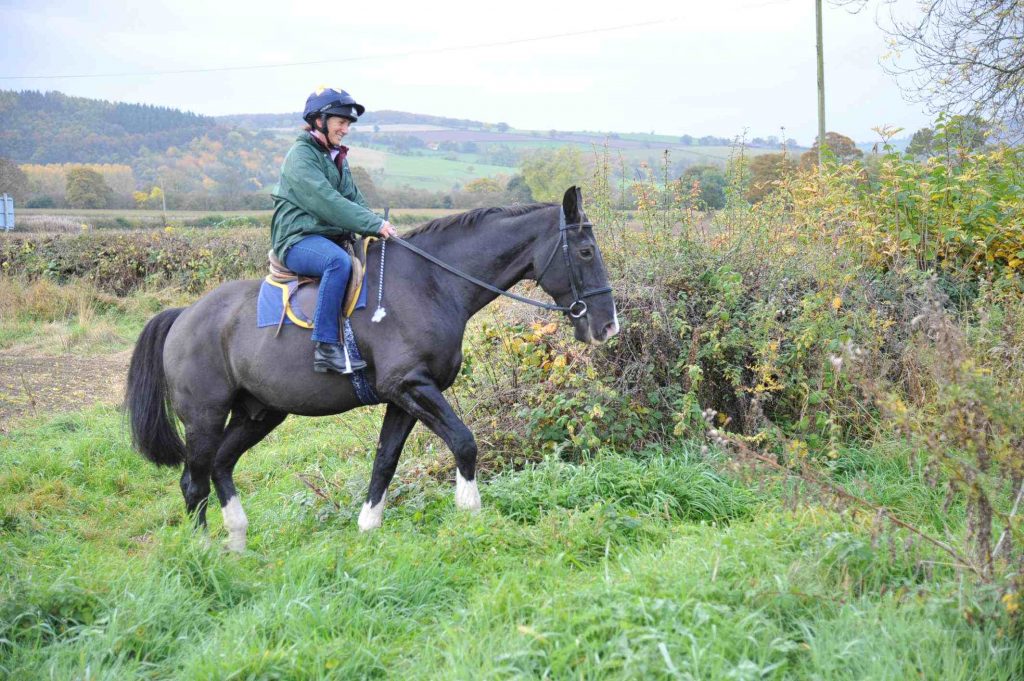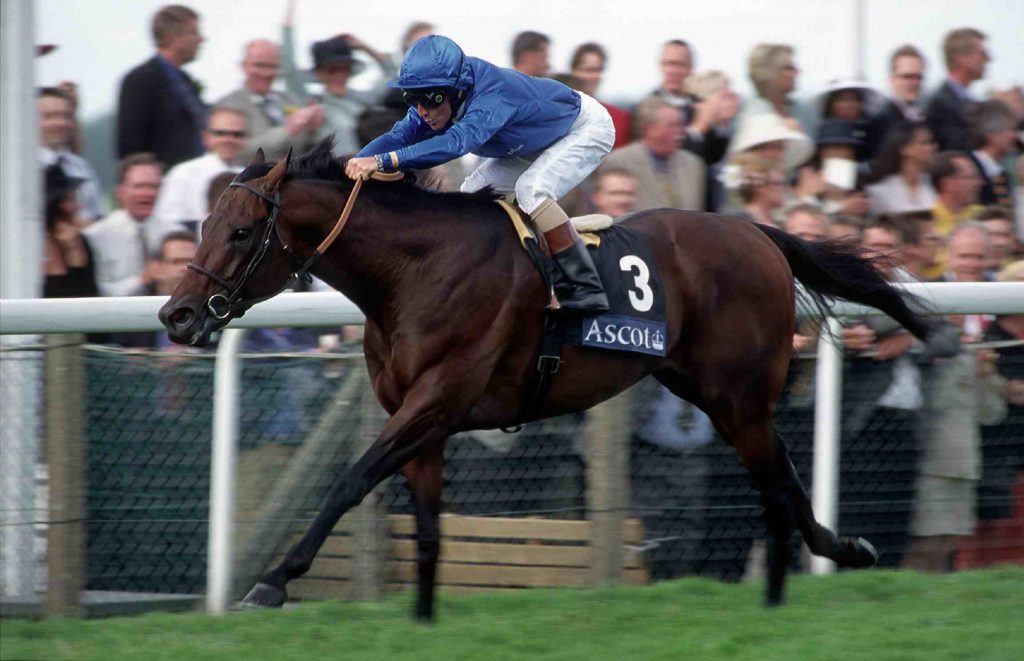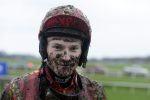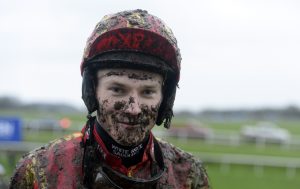A torrenting drain belches water into a Shropshire brook, and David Loder smiles with the satisfaction of a schoolboy who has just undammed a stream.
“You cannot believe the water that comes off that gallop,” he says, as we stare at the spew heading downstream in the direction of Bishops Castle. It is evidence that Loder’s carefully designed training ground has subterranean qualities to match its impressive vista above ground.
Created within the last two years amidst the rolling-hills landscape that makes this part of Britain so admired for its rural charm, it comprises an unequal triangle of woodchip that offers a pair of uphill gallops of differing distance, and the means of returning to the bottom in a circular motion by going down the other side.
“It enables us to keep horses on the move, and when they head into the chute at the top they know their work is finished,” says Loder, as we walk by his schooling grounds on grass that fills the centre of the triangle – and, of course, for a man who seeks perfection, no ordinary grass.
I still assess yearlings for Sheikh Mohammed – although I’m busy with that work when the jumps is quiet – and don’t want that side of my business to become confused with the set-up here
“It’s the Newmarket Heath mix,” he says proudly. “It’s tough and hardy, and goes in at 150 times your normal seeding rate, so it’s far denser than a grass field and gives a better cushion.”
The cost of his investment both here and at the 35-box yard he has created on land owned by his father-in-law, Bill Sykes, has been considerable – a seven-figure sum would be a reasonable estimate by a lay man – and yet Loder gains pleasure in recalling that the miles of plastic running rail which hem the woodchip were bought for a bargain price when a Lincolnshire point-to-point course closed.
Anyone who has switched off from racing for the past ten years would be surprised to read that Loder is based in Shropshire, let alone that he has schooling grounds, and is now a trainer of jumpers – he gained a licence in the autumn and sent out his first jumps winner in December. Once positioned in Newmarket on the top step of Flat racing’s escalator of youthful training talent – his first winner, Lupescu, came in a Listed race – he is a Classic-winning trainer who handled some of Sheikh Mohammed’s most precious racehorses, including, as a two-year-old, the greatest of them all, Dubai Millennium.
Yet his latest venture, on the opposite side of England is, in effect, a return to his roots.
He says: “At 18 I went to Ascot and bought my first horse with a view to riding him in point-to-points. He was called King Vince, he cost £1,100, I finished second on him at 50-1, and got him away for £1,500. That was my first trade, but working with horses was all I ever wanted to do. It was in my blood.”
I haven’t gone down the route of trying to buy horses from the Flat – it’s like buying a second-hand car. I prefer to buy unbroken stores because you have a better chance of getting a very good one
Early inspiration had come from several sources, not least the Loder family’s Eyrefield Lodge Stud on the Curragh, which is owned by David’s cousin, Sir Edmund Loder.
This time last year, Alan McCabe was training from Loder’s Shropshire premises, but felt there were better opportunities for his Flat interests in Newmarket and has returned there with his family. Loder took on the licence, but unlike McCabe has no desire to handle Flat horses.
“It complicates things,” he says. “I still assess yearlings for Sheikh Mohammed – although I’m busy with that work when the jumps is quiet – and don’t want that side of my business to become confused with the set-up here. It’s a long drive to a decent Flat course, but we have jumps tracks close at hand, and I could see the danger that if I tried to train Flat and jumps I would be spreading the butter too thinly.
“Besides, I enjoy working with jumpers. I have a yard full of youngsters at present, but as they get older we’ll have more handicap hurdlers and chasers, too. We currently have a couple of older horses, namely Hi Vic, a chaser we bought for £7,500 at Ascot with a rating of 96, but is now on a mark of 122, and Old Pride, who started with us off 103 and is now rated 120.
“I haven’t gone down the route of trying to buy horses from the Flat – it’s like buying a second-hand car. I prefer to buy unbroken stores because I feel you have a better chance of getting a very good one. For instance, last year I bought a Ballingarry two-year-old in France and his sister has now won three chases by big margins at Auteuil – he’ll be offered at Doncaster [Loder sells through various consignors], but I won’t be giving him away.”
Old Pride is owned by Fitri Hay, while a bumper horse, Boston De La Roque, is a member of Highclere Racing’s small group of jumpers. Loder is a new face on the jumps circuit, but his CV and list of contacts have enabled him to court clients others could not hope to approach. Hi Vic, however, is owned by his mother-in-law, Pamela Sykes, a former permit holder and point-to-point trainer, whose daughter, Angie, married Loder in 2007, and with whom he now has two young daughters. Three years before the wedding, Angie, a bloodstock agent of repute, purchased Derby winner Sir Percy as a yearling.
In a large barn several miles from the main yard is another strand of Loder’s operation – inside, living like a gang of adolescents and just as cocky but easily spooked, are a group of unbroken two- and three-year-olds who are turned out in summer.
Loder says: “They are sourced from all sorts of sales, then reoffered as unbroken stores, and if they don’t sell for what we think they are worth we bring them home and train them. In the first year we sold one, Criq Rock [bought at Arqana for €16,000, resold at DBS for £40,000], who is trained by Alan King and is now a leading bumper horse – for us that sort of result is as important as having them here.
If they don’t make their money or fail to reach a sale for whatever reason, we keep them for owners who want horses in training
“Last year we sold five, including an Al Namix store bought by Warren Greatrex and a Martaline that went to Venetia Williams – they really caught my eye – and this year we have seven to offer. We want to build a reputation for having nice horses, and by offering them as untried stores there is no reason why anyone should think we are keeping the best and offering the rest. They are all untried and they are all for sale.
“If they don’t make their money or fail to reach a sale for whatever reason, we keep them for owners who want horses in training. We know the background of
these horses, and I always keep a share or two in each horse – it’s unfair on your clients to ask them to buy a horse if you are not prepared to put your money where your mouth is.
“Richard Wilkin, who is an owner here, has put together two syndicates with five horses – he has been a big help, and syndicates work well in sharing the costs.
“Similarly, if I buy a young horse I wouldn’t sell it on for at least two months until I’ve got to know it and am sure that what I’ve bought can do the job.”

Loder’s wife Angie is an integral part of the racing operation
So with both training and trading, Loder is putting together a business that whets his appetite but is less demanding than that of a 160-horse Flat trainer. That still begs the question, why, having handed in his licence in 2005 – following a virus that he, not his horses, contracted, and which proved hard to shake off while running a full-on business – has he returned to training?
“It’s different this time,” he says. “I started in 1992 and saddled 35 Group winners in my first four seasons before getting the job with Godolphin, which eventually took me to France [and an attempt to train from defunct Evry racecourse]. I was pretty ill over there – training is a stressful business, and every time I became stressed it reappeared. It dragged me down.
“I came back to Britain and went on for a few more years as a public trainer. Goodricke came along and took the Haydock Sprint Cup, and so I asked myself why was I thinking of packing up when I could still train Group 1 winners, but I had enjoyed a good run and needed a break. When I finished I went to live in Spain for a while. It was very relaxed, the weather is lovely, and the health issues cleared up.
“What I am doing now is very different – this is a beautiful place to train, I have a great set-up and believe it will become very successful. I haven’t gone at it like I did when I started training on the Flat, going all out to get as many horses as possible. I look at this as a slower burn, and making it into a good combination of buying young horses, bringing them through and hopefully training some decent winners.
“Funnily enough, even in my final year with a Flat licence I started dabbling in trading a few jumpers. I sold a couple of horses to Paul Nicholls for Harry Findlay, namely Desert Quest, who won the County Hurdle, and Herecomesthetruth, who landed the Grade 1 Scilly Isles Novices’ Chase, which helped to cement in my mind that it was a way I could go.
“I’m lucky we have some very nice owners and excellent staff – my head girl, Hannah Henney, has worked with leading sales consignors, while Gareth Thomas and Lois Williams are senior staff who work ride, box drive and look after the stores. Gareth is also responsible for a few pointers we keep in a separate yard. Some young horses are better suited to starting off in points, and point-to-pointing is popular with a few of our owners.
“I’m feeling my way a bit, because I’m dealing with young horses, but working with unraced three-year-olds is not so different from being with two-year-olds. You take them forward the same way you do a two-year-old and if they are ready to go, you go.”
One of his colleagues within the Darley/Godolphin fold, John Ferguson, has already made a name for himself within the ranks of National Hunt trainers, but recently made it known he will close down his yard in the spring to concentrate on a new role as Godolphin Chief Executive.
Loder says: “I had dinner with John in London recently and cheekily asked if any of his jumpers were looking for homes. But I think they have other plans for them.”
He makes a rueful smile, but is clearly not pining. Those days are behind him, the current model has a better work/life balance, and he is happy.
“I love the job,” he says. “You can’t beat looking at horses.”
The best I’ve ever dealt with
David Loder recalls his first conversation with his then-boss Sheikh Mohammed about the youngsters in his care. “I remember Sheikh Mohammed coming to my yard in Newmarket early in 1998 and asking me, out of the blue, which was the best of the two-year-olds. I had 60 in training for him,” Loder explains.
“It didn’t cross my mind why he had asked, but I took him to Lujain’s box and said, ‘Sir, this will win the Middle Park Stakes [which he did], and so that must rank him quite high’. However I then took him to another box and said, ‘But this is the best horse I’ve had anything to do with’. He was called Yaazer at the time, but the sheikh turned to me and said, ‘Okay, I am going to change his name to Dubai Millennium’.
“It didn’t register with me initially, but, as ever, Sheikh Mohammed had a plan and it came off.

Dubai Millennium, the outstanding runner who was trained by Loder as a juvenile
“We were just starting to get the horse going, but the way he went and with his pedigree he ticked every box. We had Desert Prince in the yard at the time, a champion three-year-old, but I knew this two-year-old was going to be better.
“To work for Sheikh Mohammed, and for him to have put up with me for as long as he has, it was marvellous to pinpoint a horse that he could call Dubai Millennium and would win the World Cup in the millennium year.
“It remains a sadness for the breed that he died so young, and his son, Dubawi, only emphasises what he might have achieved as a stallion.”



